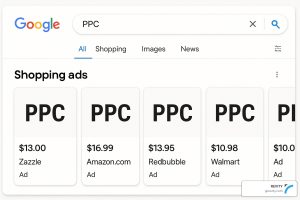A content strategy outlines how you will create, publish, and manage your content to achieve your business goals. It’s important because it helps you create content that resonates with your target audience, drives traffic to your website, and ultimately converts visitors into customers.
This article is — you’ve guessed it — all about content strategy. From defining your goals to knowing your audience to analyzing your results, we’re teaching you everything you need to know to develop a strong content strategy. Keep reading to learn more!
Step 1: Define Your Goals
Setting goals for your content strategy is important because it provides direction and focus for your content creation efforts. Without clear goals, you risk creating content irrelevant to your target audience or not aligning with your business objectives. Setting goals ensures your content is purposeful, relevant, and effective in achieving your business goals.
Goals also help you to measure the success of your content strategy. You can track key metrics to determine whether your content resonates with your audience and drives the desired actions. This allows you to make data-driven decisions about how to optimize your content strategy for better results.
Here are some examples of common content goals:
- Increase website traffic: One of the most common content goals is to drive more traffic to your website. Creating high-quality content optimized for search engines and social media can attract more visitors to your website.
- Generate leads: Another common content goal is to generate leads for your business. By creating relevant and valuable content for your target audience, you can encourage them to provide their contact information in exchange for access to gated content such as eBooks, whitepapers, or webinars.
- Build brand awareness: Content can also be used to build brand awareness and establish your business as a thought leader. Creating content that provides valuable insights and perspectives can position your business as an authority in your field and increase brand recognition.
- Improve customer engagement: Content can also improve customer engagement and foster loyalty. By creating relevant and engaging content for your existing customers, you can encourage them to stay connected with your brand and become advocates for your business.
- Increase sales: Finally, content can drive sales and revenue for your business. Creating content highlighting your products or services’ benefits and features can encourage potential customers to purchase or take other desired actions.
Setting Goals
To set goals for your content strategy, we recommend setting SMART goals. SMART is an acronym for Specific, Measurable, Achievable, Relevant, and Time-bound.
- Specific: Your goals should be clear and straightforward. Avoid setting vague goals like “increase sales” and instead set specific goals like “increase sales by 15% in the next quarter.”
- Measurable: Your goals should be measurable to track progress and determine whether you’ve achieved them. Use metrics like website traffic, engagement, and conversions to measure the success of your content strategy.
- Achievable: Your goals should be challenging but achievable. Avoid setting goals that are too easy or too difficult to achieve. Instead, set realistic goals that require effort to accomplish.
- Relevant: Your goals should be relevant to your business objectives and align with your content strategy. Avoid setting goals that don’t contribute to your business goals or are irrelevant to your target audience.
- Time-bound: Your goals should have a specific timeframe for completion—set deadlines for achieving your goals so that you can stay on track and measure progress over time.
By setting SMART goals for your content strategy, you can ensure your goals are clear, measurable, and aligned with your business objectives. This will help you to create purposeful, relevant, and compelling content that drives business results and enables you to measure your success.
Step 2: Know Your Audience
Knowing your target audience is crucial for the success of your content strategy. You need to know what’s relevant to your target audience to personalize your content, stand out from the crowd, and optimize your content.
- Relevance: Creating content relevant to your target audience is essential for engaging and retaining their interest. Understanding your audience’s needs allows you to create content that resonates and provides value.
- Personalization: Knowing your audience allows you to personalize your content to their needs and interests. This can help establish a deeper connection with your audience and increase the likelihood of them taking desired actions, such as purchasing or subscribing to your newsletter.
- Differentiation: Understanding your audience can help you to differentiate your brand from competitors. By creating content that speaks directly to your audience’s unique needs and interests, you can establish your brand as a thought leader in your industry and stand out.
- Optimization: Knowing your audience can help you optimize your content for search engines and social media. By understanding the keywords and topics your audience is searching for, you can create content that is more likely to rank well and be shared on social media.
Knowing your target audience is essential for creating purposeful, relevant, and effective content that engages your audience and drives business results.
Create Buyer Personas
Another step to knowing your audience is creating buyer personas. Buyer personas are fictional representations of your ideal customers based on market research and accurate data about your existing customers. Here are the steps to create buyer personas:
- Conduct research: Start by researching to gather information about your target audience. This can include analyzing website analytics, conducting surveys, and interviewing customers to gather insights.
- Identify commonalities: Look for commonalities among your target audience to identify key characteristics such as age, gender, job title, income, and location.
- Create profiles: Use the information gathered in your research to create detailed profiles of your ideal customers. These profiles should include their goals, challenges, interests, and behaviors.
- Give them a name and image: To make your buyer personas more tangible, give them a name and image representing their characteristics. This can create a more personal connection with your personas and make it easier to visualize them as real people.
- Use them to guide your content strategy: Once you have created your buyer personas, use them to guide your content strategy. Create content that speaks directly to their needs, interests, and pain points, and use their characteristics to inform your content creation, distribution, and promotion strategies.
Tips for Creating Buyer Personas
Here are some tips on how to research your audience to create buyer personas:
- Analyze website analytics: Use tools like Google Analytics to analyze your website traffic and gather insights about your audience’s demographics, behavior, and interests.
- Conduct surveys: You can use tools like SurveyMonkey or Google Forms to create and distribute surveys.
- Interview customers: Conduct one-on-one interviews with your customers to gather insights about their experiences with your brand.
- Use social media: Monitor social media conversations related to your brand and industry to gather insights about your audience’s interests, behaviors, and preferences.
- Look at industry research: Look for industry research and reports that provide insights about your target audience’s demographics, behaviors, and preferences.
- Talk to your sales team: Talk to your sales team to gather insights about your audience’s needs and objections.
- Use customer data: Use customer data such as purchase history and customer feedback to gain insights about your audience’s behaviors and preferences.
By using these research methods, you can gather insights about your target audience and create buyer personas that accurately represent their needs, preferences, and pain points. This will help you to create content that resonates with your audience and drives business results.
Step 3: Conduct a Content Audit
A content audit systematically reviews and evaluates your website’s content to determine its quality, relevance, and effectiveness. A content audit aims to identify improvement areas and create a plan for optimizing your content to meet the needs of your audience better and achieve your business goals.
During a content audit, you will typically create a spreadsheet or document that includes the following information for each piece of content on your website:
- URL: The URL of the content page.
- Title: The title of the content page.
- Type of content: The type of content, such as blog posts, product pages, or landing pages.
- Author: The author of the content.
- Publication date: The date the content was published.
- Performance metrics include page views, bounce rate, and time on the page.
- Quality assessment: A subjective assessment of the quality of the content, including factors such as accuracy, relevance, and readability.
- Optimization opportunities: Opportunities for improving the content, such as adding internal links, optimizing for keywords, or updating outdated information.
Benefits of a Content Audit
Conducting a content audit can benefit your website and overall content strategy.
- Identify gaps and opportunities: A content audit can help you identify gaps in your content and opportunities for improvement. By reviewing your content, you can identify areas where you may need more content or where your content needs to meet the needs of your audience.
- Improve content quality: By assessing the quality of your content during a content audit, you can identify areas where your content can be improved. This can include updating outdated information, improving readability, and ensuring accuracy.
- Increase engagement: This can include improving the user experience, making your content more visually appealing, and ensuring that your content is relevant and valuable to your audience.
- Improve search engine rankings: This can include optimizing for keywords, improving internal linking, and ensuring your content is up-to-date and relevant.
- Streamline content creation: By understanding the types of content that are most effective and valuable to your audience, you can streamline your content creation process. This can help you to focus your resources on creating high-quality content that resonates with your audience and drives business results.
How to Conduct a Content Audit
- Define your goals: Before you begin your content audit, define your goals. What do you want to achieve with your content? Do you want to increase engagement, improve search engine rankings, or drive conversions?
Defining your goals will help you focus your content audit and ensure that you evaluate your content based on the metrics that matter most to your business. - Gather your content: Create a list of all the content on your website, including blog posts, product pages, landing pages, and any other content that you have created. You can use tools such as Google Analytics or a site crawler to help you gather this information.
- Evaluate your content: Review each piece of content and evaluate its quality, relevance, and effectiveness. You can use a spreadsheet or document to record your findings, including the URL, title, type of content, author, publication date, performance metrics, quality assessment, and optimization opportunities.
- Identify gaps and opportunities: Use the findings from your content audit to identify gaps in your content and opportunities for improvement.
Are there areas where you need more content? Are there pieces of content that are not meeting the needs of your audience? Use this information to create a plan for optimizing your content and filling any gaps you have identified. - Optimize your content: Based on the findings of your content audit, create a plan for optimizing your content. This may include updating outdated information, improving readability, optimizing for keywords, and adding internal links. Make sure that your content is relevant, valuable, and engaging for your target audience.
- Monitor and update: Conducting a content audit is not a one-time task. You should regularly monitor and update your content to ensure that it continues to meet the needs of your audience and achieve your business goals. Set a schedule for reviewing and updating your content regularly.
By following these steps, you can conduct a content audit that helps you to identify gaps and opportunities in your content, optimize your content for your target audience, and achieve your business goals.
Step 4: Determine Your Unique Value Proposition
A unique value proposition (UVP) is a statement describing the unique benefit that your product or service provides to your target audience. It explains why your product or service differs from your competitors and how it solves a specific problem or meets a specific need for your customers.
A strong UVP is crucial because it helps you stand out in a crowded marketplace and differentiates your brand from your competitors. It also helps communicate the value of your product or service to your target audience and can be a key factor in driving conversions and sales.
To determine your unique value proposition, follow these steps:
- Define your target audience: Who are your ideal customers? Understanding your target audience is essential to creating a UVP that resonates with them.
- Identify your competitors: Who are your main competitors? What are their strengths and weaknesses? Understanding your competitors is important to creating a UVP that differentiates your brand from theirs.
- Identify your unique benefits: What unique benefits does your product or service provide to your target audience? What sets you apart from your competitors? These unique benefits should be the foundation of your UVP.
- Write your UVP: Use your gathered information to create a clear and concise statement that communicates your unique benefits to your target audience. Your UVP should be no more than a sentence or two and clearly explain why your product or service is the best choice for your customers.
- Test and refine: Once you have created your UVP, test it with your target audience to see how well it resonates with them. Refine your UVP based on their feedback and continue to test and refine until you have a UVP that effectively communicates the unique benefits of your product or service to your target audience.
By following these steps, you can create a strong UVP that differentiates your brand from your competitors and effectively communicates the value of your product or service to your target audience.
Step 5: Choose Your Content Types and Channels
When choosing the right content types and channels, it’s important to consider your audience and goals. Here are some different types of content you can choose from:
- Blog posts: Blog posts are a great way to share information, provide value to your audience, and improve your search engine rankings. They can be in the form of how-to guides, listicles, opinion pieces, and more.
- Videos: Videos are a highly engaging form of content that can be used to educate, entertain, and inspire your audience. Examples include explainer videos, interviews, product demos, and more.
- Infographics: Infographics are a visually appealing way to present information and data. They can be used to simplify complex topics and make them easier to understand.
- E-books and whitepapers: E-books and whitepapers are longer-form content pieces that provide in-depth information and insights on a specific topic. They can be used to establish your brand as a thought leader and provide value to your audience.
- Social media posts: Social media posts are a great way to engage with your audience and build brand awareness. They can be in the form of images, videos, or text-based posts.
Choosing the Type of Content
When choosing the right content types and channels for your audience and goals, here are some tips to keep in mind:
- Know your audience: Understand your target audience and their preferences. What type of content do they prefer? Which channels do they use most often?
- Consider your goals: What do you want to achieve with your content? Are you trying to drive traffic to your website, generate leads, or increase sales? Choose content types and channels that align with your goals.
- Leverage your strengths: Choose content types and channels that align with your strengths and resources. If you’re great at creating videos, focus on creating video content. If you have a large following on Instagram, focus on creating social media content.
- Test and refine: Test different content types and channels to see what resonates with your audience and achieves your goals. Refine your content strategy based on your findings and continue to test and refine it over time.
By considering your audience and goals, leveraging your strengths, and testing and refining your content strategy, you can choose the right content types and channels to engage with your audience and achieve your business goals effectively.
Content Channels
There are several content channels available for posting your content. Here are some of the most common channels:
- Website: Your website is the hub of your online presence and the primary place to publish and host your content. You can create blog posts, product pages, landing pages, and more on your website.
- Social media: Social media platforms such as Facebook, Twitter, Instagram, and LinkedIn are great channels for promoting your content and engaging with your audience. You can share blog posts, videos, images, and other types of content on social media.
- Email: Email is a highly effective channel for distributing your content to subscribers. You can send newsletters, promotional emails, and other types of content directly to your audience’s inbox.
- Podcasts: Podcasts are a popular channel for creating audio content. You can create your own podcast and distribute it on platforms such as Apple Podcasts, Spotify, and Google Podcasts.
- YouTube: YouTube is a popular channel for creating and sharing video content. You can create your own YouTube channel and share videos on various topics.
- Guest posting: Guest posting involves creating content for other websites or blogs in your industry. This can help you reach a wider audience and build backlinks to your website.
- Online communities: Online communities such as forums, Reddit, and Quora can be great channels for sharing your content and engaging with your target audience.
When choosing the right content channels for your business, it’s important to consider your target audience and their preferences.
Choose channels that align with your audience’s preferences and behavior. It’s also important to consider your goals and resources. Choose channels that align with your goals and that you have the resources to manage effectively.
You can effectively distribute your content and engage with your audience by leveraging the right content channels.
Step 6: Develop a Content Calendar
Developing a content calendar can be a crucial part of your content marketing strategy, as it helps with consistency, efficiency, and alignment.
Why Content Calendars Matter
- Consistency: A content calendar helps you plan and organize your content in advance, ensuring that you publish content consistently and on a regular basis.
- Efficiency: Planning your content can save you time and make your content creation process more efficient. You can batch-create content and schedule it beforehand, freeing up time for other tasks.
- Alignment: A content calendar can help ensure your content is aligned with your overall marketing goals and messaging. You can plan content around specific campaigns or promotions and ensure your messaging is consistent across all channels.
Creating a Content Calendar
- Choose a format: You can create a content calendar using a spreadsheet, a project management tool, or a dedicated content calendar tool.
- Determine your frequency: Decide how often you want to publish content and create a schedule accordingly. You can publish content daily, weekly, or monthly, depending on your goals and resources.
- Brainstorm content ideas: Brainstorm a list of content ideas that align with your goals and messaging. You can also consider seasonal or trending topics to add to your calendar.
- Assign owners: Assign owners for each piece of content to ensure accountability and ensure that everyone knows their role in the content creation process.
- Schedule and publish: Once you’ve created your content calendar, start scheduling your content and posting it according to your schedule.
Managing a Content Calendar
- Review and update regularly: Review your content calendar regularly to ensure it’s up to date and aligned with your goals. Update it as needed to reflect changes in your marketing strategy or goals.
- Monitor performance: Monitor the performance of your content and adjust your calendar accordingly. If certain types of content or channels perform better than others, adjust your calendar to focus more on those areas.
- Collaborate with your team: Collaborate with your team to ensure everyone is aligned on the content calendar and knows their role in the content creation process.
- Be flexible: Be flexible and adjust your content calendar as needed. If a new opportunity arises or a piece of content isn’t performing well, be willing to make changes to your calendar.
Creating and managing a content calendar ensures that your content is consistent, efficient, and aligned with your overall marketing goals.
Step 7: Create and Publish Your Content
Creating high-quality content is essential for engaging your audience and achieving your content marketing goals. Here are some tips for creating high-quality content.
- Focus on quality over quantity: It’s better to create a few high-quality pieces of content than to churn out a lot of low-quality content. Take the time to research, write, and edit your content to ensure its high quality.
- Use visuals: Incorporating visuals such as images, videos, and infographics can make your content more engaging and shareable.
- Provide value: Whether it’s educational, entertaining, or inspiring, your content should offer something of value to your audience.
- Use storytelling: Storytelling can help make your content more relatable and engaging. Incorporate stories and anecdotes into your content to make it more memorable.
- Optimize for SEO: Optimizing your content for search engines can help it rank higher in search results and drive more traffic to your website. Use relevant keywords and optimize your headlines, meta descriptions, and content structure.
- Edit and proofread: Editing and proofreading your content can help ensure it’s error-free and easy to read. Take the time to review your content and make any necessary edits before publishing.
- Be original: Creating original content that offers a unique perspective or insight can help your content stand out from the crowd. Avoid copying or duplicating content from other sources.
Step 8: Measure and Analyze Your Results
When measuring and analyzing your results, there are several key metrics to track. Here are some common metrics to consider:
- Website traffic: Tracking the website traffic can help you understand how many people visit your website, which pages they visit, and how long they stay. This can be measured using tools like Google Analytics.
- Engagement metrics: Engagement metrics such as likes, shares, comments, and click-through rates can help you understand how your audience interacts with your content. These metrics can be tracked on social media platforms, email campaigns, and website analytics tools.
- Conversion rates: Conversion rates measure how many people take a desired action on your website, such as filling out a form, making a purchase, or downloading a resource. This can be tracked using conversion tracking tools in Google Analytics or other marketing automation platforms.
- Return on investment (ROI): ROI measures how much revenue your content marketing efforts are generating compared to how much you’re spending on them. This can be calculated by tracking revenue generated from content marketing campaigns and comparing it to the cost of creating and promoting the content.
- Search engine rankings: Tracking your search engine rankings can help you understand how your content is performing in search results and identify opportunities for improvement. This can be tracked using tools like Google Search Console.
By tracking these key metrics, you can measure the effectiveness of your content marketing efforts and make data-driven decisions for future content creation.
Take Your Content Strategy to the Next Level With REVITY
Creating a successful content marketing strategy requires time and effort, but the results are well worth it. By following the tips outlined in this blog post, you can create high-quality content that engages your audience, drives traffic to your website, and ultimately helps you achieve your marketing goals.
At Revity, we understand the importance of content marketing in today’s digital marketing landscape. That’s why we offer a range of digital marketing services to help businesses like yours succeed online. From content creation and social media management to SEO and PPC advertising, we have the expertise and experience to help you achieve your marketing goals.Look no further if you’re looking for a partner to help you create and execute a successful content marketing strategy. Contact Revity online or call us at 801-895-4043 today to learn more about our marketing services and how we can help your business succeed.
































